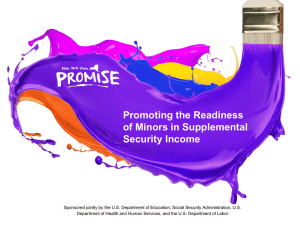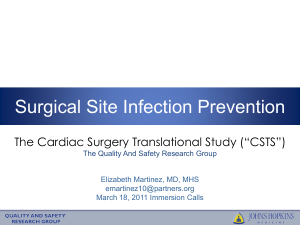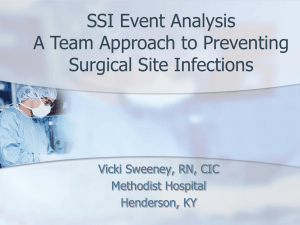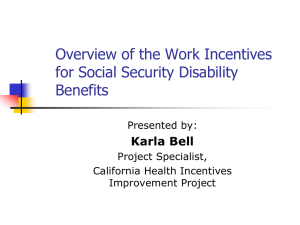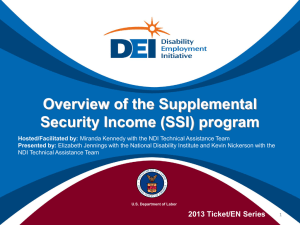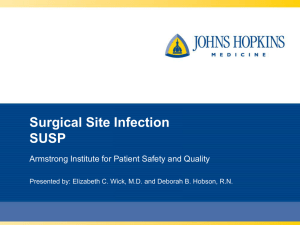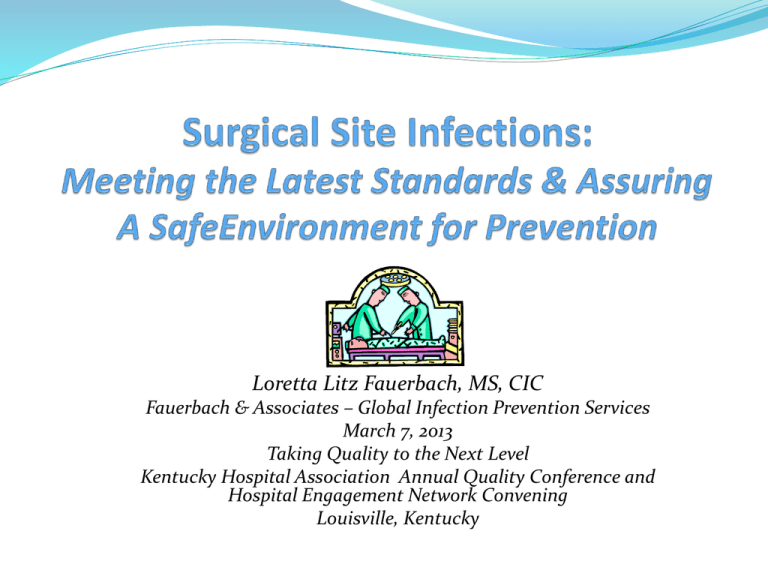
Loretta Litz Fauerbach, MS, CIC
Fauerbach & Associates – Global Infection Prevention Services
March 7, 2013
Taking Quality to the Next Level
Kentucky Hospital Association Annual Quality Conference and
Hospital Engagement Network Convening
Louisville, Kentucky
Objectives
To identify the components in the Surgical Care Improvement
Project
To discuss CMS SSI reporting requirements to NHSN
To clarify NHSN methodology
To identify other quality initiatives related to SSI prevention
To identify key stake holders and reporting mechanisms for a
strong surgical site infection prevention program.
To identify challenges with data collection and strategies to
improve communications related to identifying surgical site
infections
To discuss accrediting and licensing requirements related to SSI
prevention
LLF SSI Standards 2013
Impact of SSIs
Occur in 2%-5% of patients undergoing inpatient
surgery in the United States.
Approximately 500,000 SSIs occur each year
7-10 additional post operative hospital days
2-11 times higher risk of death compared to patients who
do not have an SSI
Patients with an SSI have a 2-11 times higher risk of
death, compared with operative patients without an SSI.
77% of deaths in patients who have an SSI are directly
attributable to SSI
Attributable costs vary depending on procedure and
organisms but range from $3000 to $29,000
SSIs are believed to account for up to $10 billion
annually in healthcare expenditures.
LLF SSI Standards 2013
SSI Burden of Illness
Surgical Site Infections:
Represent 20 percent of all health care-associated infections
reported to the National Nosocomial Infections Surveillance
System (NNIS) in 2002.
Result in more than 8,000 deaths a year and occur in up to 25
percent of patients following major surgical procedures.
Extend average length of stay by 9.7 days while increasing
cost by $20,842 per admission.
Are preventable in an estimated 40 to 60 percent of cases.
Surgical Site Infections (SSI’s)
General Background
•2.6% of 30 million operations complicated by SSI’s
•SSI’s Second most common healthcare associated
infection accounting for 17% of all hospital
acquired infections
• SSI’s most common healthcare associated infection
in surgical patients (38%)
•Consequences of SSI
•Increased hospital stay by up to 10 days
• Increased hospital costs
• Increased readmission rates
• Increased pain and suffering
LLF SSI Standards 2013
CDC, 2003
National Patient Safety Goal
NPSG.07.05.01
Implement best practices for
preventing surgical site infections.
• CDC Guideline for the Prevention of
Surgical Site Infections
• SHEA Compendium
• IHI Bundle Care
LLF SSI Standards 2013
Health & Human Services
Infection Prevention Plan for Surgical Site Infections
• SSI 1
• Deep incision and organ space infection rates using
NHSN definitions (SCIP procedures)
• Goal: CDC NHSN Median deep incision and organ space
infection rate for each procedure/risk group will be at or below
the current NHSN 25th percentile
• Measure: Surgical site infection rate: Deep wound and organ
space infections as a result of elective surgery to include
coronary artery bypass graft (CABG) and cardiac surgery; hip or
knee arthroplasty; colon surgery; hysterectomy (abdominal and
vaginal); and vascular surgery.
LLF SSI Standards 2013
Health & Human Services
Infection Prevention Plan for Surgical Site
Infections
SSI 2
Adherence to SCIP/NQF infection process measures (perioperative antibiotics, hair
removal, postoperative glucose control, normothermia) CMS SCIP
Goal: 95% adherence rates to each SCIP/NQF infection
process measure.
Cardiac surgery patients with controlled postoperative serum
glucose; Surgery patients with appropriate hair removal;
Prophylactic antibiotics received; Prophylactic antibiotics selection;
Prophylactic antibiotics discontinued
Measure: Compliance with Centers for Medicare and Medicaid
Services antimicrobial prophylaxis guidelines.
LLF SSI Standards 2013
Evidence-Based Practice Guidelines for
Surgical Site Infection Prevention
Four components of care include:
1. Appropriate use of prophylactic antibiotics
Prophylactic antibiotic received within one hour prior to surgical
incision
Prophylactic antibiotic selection for surgical patients consistent
with national guidelines
Prophylactic antibiotics discontinued within 24 hours after
surgery end time (48 hours for cardiac patients)
2. Appropriate hair removal (if deemed necessary, remove using
clippers or depilatory)
Evidence-Based Practice Guidelines for
Surgical Site Infection Prevention
3. Controlled postoperative serum glucose in cardiac
surgery
•
Glucose control is defined as serum glucose levels below
200 mg/dl, collected at or closest to 6:00 a.m. on each of
the first two postoperative days
• Tight glucose control (using an insulin drip) is often
performed in an intensive care setting
4. Immediate postoperative normothermia in
colorectal surgery
LLF SSI Standards 2013
Evidence-Based Practice Guidelines for
Surgical Site Infection Prevention
Additional SCIP changes in care:
• Beta blockade for patients on beta blockers prior to
admission should be continued postoperatively
• Venous thromboembolism prophylaxis
• Ventilator-associated pneumonia prevention
Source: Institute for Healthcare Improvement, How-to Guide: Prevent
Surgical Site Infections. (2012)
http://www.ihi.org/explore/SSI/Pages/default.aspx Accessed 7/11/12.
LLF SSI Standards 2013
The Florida Surgical Care Initiative (FSCI)
A partnership between the Florida Hospital
Association (FHA) and the American
College of Surgeons (ACS), and endorsed by
the Florida Chapter of the ACS,
Focus initially on four outcome measures of
the ACS National Surgical Quality
Improvement Program (NSQIP)
LLF SSI Standards 2013
FSCI Surgical Outcome Measures
Standard ACS NSQIP* measures that are
followed from pre-op to 30 days post-discharge
surgical site infection (SSI),
urinary tract infection (UTI),
colorectal outcomes and
elderly surgery outcomes
* ACS NSQIP - significantly decrease patient mortality and morbidity rates (Annals of
Surgery, 250:363-376, September 2009)
LLF SSI Standards 2013
LLF SSI Standards 2013
FSCI Unique Approach to Measurement
Uses medical chart data gathered by clinically trained personnel
rather than insurance claims data derived from medical bills
Adjusts for risk so that the patient’s condition is taken into
consideration when assessing the outcome
Evaluates how the patient is doing a month after his or her
operation, since more than half of complications occur after
discharge
Builds commitment and collaboration among surgeons, surgical
teams and hospitals, because it is based on the highest quality
data
LLF SSI Standards 2013
LLF SSI Standards 2013
Ambulatory Surgery Care Standards
CMS State Operations Manual, Appendix L, Part I
ASC Survey Protocol, and Part II General
Conditions and Requirements
http://www.cms.gov/Regulations-andGuidance/Guidance/Manuals/downloads/som107
ap_l_ambulatory.pdf
May also be accessed through the AAAHC.org
website
Very Similar to CMSCDC/SHEA/TJC
recommendations for hospitals
LLF SSI Standards 2013
ASC
416.51 Infection Control
The ASC must maintain an infection control
program that seeks to minimize infections and
communicable diseases
LLF SSI Standards 2013
ASC Key Elements of a Risk Assessment
Make it your own through a formal Risk Assessment
Collaborative effort
Regularly reviewed and updated
Governing body review
Forms the basis for your written Infection
Prevention Plan including goals and measureable
objectives
LLF SSI Standards 2013
Risk Assessment for Facility’s
Unique Practice Setting
Identify Risks for Transmission
Populations
Surveillance data
Procedures – general and
specialty care procedures
Geographic Location/Weather
Size of Facility
Referral Patterns
Organisms and risks common to
the community (endemic
occurrences)
including HAIs and
process monitoring
Construction
Cleaning, Disinfection
Sterilization
Supply Chain
Staffing
Medical
ASC staff
LLF SSI Standards 2013
Types of Infections
Surgical Site Infections
CA-UTI
Intravenous Catheters including CLA-BSIs
C. difficile or other GI pathogens
Respiratory Illness
Resistant Organisms
LLF SSI Standards 2013
Collaboration is Key Part of
IP Risk Assessment
Interdisciplinary Input
Infection
Prevention Team
Medical Staff
Nursing Staff
Administration
Other Leaders
LLF SSI Standards 2013
Other potential
participants
Patients
Public Relations
Public Health
3rd Party Payors
Set Goals Based on Risk Assessment
High Risk - High Volume
Likelihood of event occurring
Key Risks
Determine top priority
Set Goals
Establish measurements to evaluate goals
Set protocols for obtaining the data for the
measurements
LLF SSI Standards 2013
Infection Prevention Program and
QA/PI Program Linkage
416.51(b) …”ongoing program designed to
prevent, control, and investigate ..”
416.51(b)(2) …”an integral part of the ASC’s
quality assessment and performance
improvement program..”
LLF SSI Standards 2013
Basic Program Elements
SSI Prevention
Hand Hygiene
Cleaning, Disinfection and Sterilization
Safe Injection Practices
LLF SSI Standards 2013
Qualified IP Required
416.51 Condition for Coverage – Infection Control:
“The ASC’s infection control program must be
directed by a designated health care professional
with training in infection control.”
ICSW Item #17 – “Does the ASC have a licensed
health care professional qualified through
training in IC and designated to direct the ASC’s
IC program?”
LLF SSI Standards 2013
Impact of ICSW Item #17:
“If the ASC cannot document it has designated a
qualified professional with training in IC to direct
its IC program, a deficiency must be cited.
Lack of a designated professional responsible for
IC should be considered .. for a Condition level
deficiency related to 416.51.”
LLF SSI Standards 2013
Common Citations
Written materials are
needed, yet are absent,
incomplete, or insufficient
to meet the standards
Governing body formal
meeting minutes
Policies & procedures
Required recordkeeping
such as logs
Evidence of delegation of
responsibilities
Evidence of compliance with
policies
Cleaning, disinfection, and
sterilization of instruments,
equipment and supplies,
environmental cleaning
Manufacturer’s
Recommendations
Follow AAMI, AORN, CDC
LLF SSI Standards 2013
Common Citations
Safe Injection Practices
Nationally recognized
guidelines adopted by your
organization’s Governing
Body as evidenced in
formal meeting minutes
Most current version
Adherence
Education
Surveillance
LLF SSI Standards 2013
One Needle, One Syringe,
One Patient, One Time
Outbreaks due to improper
use of single dose vials,
syringes and needles
Single patient use vials are
single patient use, unless
drawn up under a certified
pharmacy hood, no
exceptions!
Common Citations
Procedures to minimize
risk of Infection including
Surveillance
NHSN
CDC Guidelines
Definitions
Patient Safety Goals
Methodology
AORN
Comparisons
Process Monitoring
Outcome Monitoring
Targeted activities- high risk
/high volume
Legislative Mandates
LLF SSI Standards 2013
Tips for Success for
Accreditation Survey
1.
2.
3.
4.
5.
Present the most current standards book upfront.
Prepare for the challenging aspects
Set up a space for the surveyor to work
Document quality and infection prevention
initiatives
Prepare a list of physicians and staff
a) Make sure credentials are in order
b) Have evaluations and education/orientation records
readily available
LLF SSI Standards 2013
Key Resources
Accreditation Association for Ambulatory Health
Care
www.aaahc.org
info@aaahc.org for general questions
Association for Professionals in Infection Control
www.apic.org
Safe Injection Practices
www.oneandonlycampaign.org
Center for Disease Control
www.cdc.gov
LLF SSI Standards 2013
Basic practices for prevention and
monitoring of SSI:
1. Perform surveillance for SSI (A-II).
2. Provide ongoing feedback on SSI surveillance and
process measures to surgical and perioperative
personnel and leadership (A-II).
3. Increase the efficiency of surveillance through the use
of automated data (A-II).
LLF SSI Standards 2013
CDC SSI Guideline 1999
SSI Surveillance Methods
Daily Direct Observation by trained person starting 24-48
hours after surgery
Considered to be the most accurate method of surveillance,
but rarely used due to resource limitation
Indirect SSI surveillance using a combination of sources
Microbiology and Patient Records
Survey of surgeons and patients
Re-admission tracking
Other information including coded dx, or op reports
Efficacy of Indirect Surveillance
Less time consuming, IP can perform during surveillance
rounds
Reliable (sensitivity, 84%-89%) and specific (specificity,
99.8%) when compared to “gold standard” of direct
surveillance.
LLF SSI Standards 2013
CDC SSI Guideline 1999
Automated Surveillance
Expanded by using hospital databases
data on administrative claims,
days of antimicrobial use,
readmission to the hospital,
return to the operating room
Automatically import data
microbiologic culture data,
surgical procedure data, and
general demographic information
Improve the sensitivity of indirect
surveillance for detection of SSI
Improve IP efficiency in data collection
LLF SSI Standards 2013
CDC SSI Guideline 1999
Perform Surveillance
High Risk - High Volume
Identify, collect, store, and analyze data needed for the
surveillance program.
Implement a system for collecting data needed to
identify SSIs.
Develop a database for storing, managing, and
accessing collected data on SSIs.
Prepare periodic SSI reports (the time frame will
depend on hospital needs and volume of targeted
procedures).
LLF SSI Standards 2013
CDC SSI Guideline 1999
Perform Surveillance
Collect denominator data on all patients
undergoing targeted procedures, to calculate SSI
rates for each type of procedure
Identify trends (eg, in rates of SSI and pathogens
causing SSIs).
Use CDC and NHSN definitions of SSI
Perform indirect surveillance for targeted
procedures.
Perform postoperative surveillance for 30 days; if
prosthetic material is implanted during surgery
then follow for 12 months
LLF SSI Standards 2013
CDC SSI Guideline 1999
Special Approaches for SSI Prevention
Perform an SSI Risk
Assessment
Perform Expanded SSI
Surveillance
Identify areas that
Determine the source, extent
surveillance data suggest
lack of effective control.
Elements to Consider
High Risk -High Volume
Surveillance Data
Rates
Processes
Organisms
Strategies
LLF SSI Standards 2013
of the problem, and to
identify potential
interventions
Case finding
Observational Studies
Check adherence rates
to best practices
CDC SSI Guideline 1999
Post Discharge SSI Surveillance
More Procedures are being done in outpatient setting
Shorter Post OP stays for Inpatients
No standard method for Post OP SSI surveillance
o Questionnaires to patients, surgeons, or clinics
o Shown to have poor sensitivity and specificity
Rates do increase after Post Op Surveillance implemented
Superficial incisional infections usually managed as
outpatient
Deep incisional and organ/space infections typically require
readmission to the hospital for management.
LLF SSI Standards 2013
CDC SSI Guideline 1999
LLF SSI Standards 2013
Infrastructure Requirements
Trained personnel
Infection prevention and control personnel
SSI surveillance,
Able to apply CDC definitions of SSI,
Basic computer and mathematical skills, and
Good communication skills and adept at
providing feedback and education to healthcare
personnel when appropriate
• NSQIP – surveillance nurse
LLF SSI Standards 2013
CDC SSI Guideline 1999
Computer Assisted Decision Support
Creating automatic reminders
Use computer support to improve pre-op
administration of antimicrobial prophylaxis
Initial and repeat doses
Stop orders
Utilization of automated data
Tracking
Monitoring
LLF SSI Standards 2013
Feedback
Provide ongoing feedback on SSI surveillance and
process measures to surgical and perioperative
personnel and leadership (A-II).
Routinely provide feedback on SSI rates and process
measures to individual surgeons and hospital
leadership.
For each type of procedure performed, provide risk
adjusted rates of SSI.
Anonymously benchmark procedure-specific risk
adjusted rates of SSI among peer surgeons.
Confidentially provide data to individual surgeons,
the surgical division, and/or department chiefs.
LLF SSI Standards 2013
Will automation and reminders help?
30% of SSI are preventable
with appropriate use of
preoperative antibiotics*
LLF SSI Standards 2013
*Dellinger EP 2005
Prevention of SSI: Process
•MD to treat any existing infection at remote site
(urine, bloodstream, etc.)
Remove hair only when necessary
»Do not shave
»When necessary, use clippers or depilatories
• Control hyperglycemia
Implement preoperative showers--CHG preferred
• Administer surgical prophylaxis according to
guidelines
• Maintain appropriate oxygenation control
• Maintain normothermia/control of hypothermia
LLF SSI Standards 2013
CDC SSI Guideline 1999
SSI Complexity
Microbial characteristics (eg, degree of
contamination and virulence of pathogen)
Patient characteristics (eg, immune status and
comorbid conditions)
Surgical characteristics (eg, type of procedure,
introduction of foreign material, and amount of
damage to tissues)
LLF SSI Standards 2013
Extrinsic Procedure Related
Perioperative: Patient Preparation
Hair Removal
Pre-Operative Infections
Do not remove hair unless
Identify and treat remote
hair will interfere with the
operation
If hair removal is necessary
remove by clipping.
Do not use razor. A I
LLF SSI Standards 2013
infections prior to elective
surgical procedures. A II
CDC SSI Guideline 1999
SSI Prevention Guidelines
Preparation of Patient
Do Not Remove Hair at the incision site, unless it will
interfere with surgery itself.
If the hair must be removed, do it directly beforehand,
preferably with electric clippers. (1A)
Pre-surgical patients should perform an
antiseptic
shower at least the night before and preferably also the
morning of the scheduled surgery. Wash and clean the
incision site area, scrubbing lightly to remove any gross
skin contamination prior to antiseptic surgical
preparation. (1B)
LLF SSI Standards 2013
CDC,
Hair Removal Method
Shaving versus Clipping
Hair Removal Method
Clean Wound Infection
Rate (%)
Shaved with razor
Clipped
Electric razor
Not shaved, not clipped
Depilatories
2.5
1.7
1.4
0.9
0.6
The increased risk with shaving prior to the operation is associated
with microscopic cuts and shaving immediately before seriously
reduces the SSI risk ( 20% risk if shaved > 24hrs--CDC, 1999).
Cruce and Forde, 1981
LLF SSI Standards 2013
Implement evidence based standards
(A-II)
Policies and practices should include but are not
limited to the following:
Reducing modifiable patient risk factors
Optimal cleaning and disinfection of equipment
and the environment
Optimal preparation and disinfection of the operative site
and the hands of the surgical team members
Adherence to hand hygiene
Traffic control in operating rooms
LLF SSI Standards 2013
CDC SSI Guideline 1999
Intrinsic Patient Related - Perioperative
Modifiable
Un-Modifiable
Un-modifiable
Age
Increase dosing pre-op antimicrobial
No formal recommendation:
relationship to increased SSI
due to comorbidities or
immune status.
LLF SSI Standards 2013
• Obesity
prophylaxis for morbidly obese
patients.A-II
Smoking Cessation
Encourage within 30 days before
procedure A-II
Immunosuppressive Meds
No formal recommendations
Avoid if possible in perioperative
period if possible.C-II
• Glucose Control, diabetes
Control serum glucose levels
Reduce glycosylated hemoglobin A1c
levels to <7% before surgery, if
possible
CDC SSI Guideline 1999
Operative Characteristics
Surgical Scrub
Use appropriate antiseptic agent to perform 2-5 minute
preoperative surgical scrub or an alcohol-based surgical hand
antiseptic product. A-II
Skin Preparation
Wash and clean skin around incision site; use an appropriated
antiseptic agent. A-II
LLF SSI Standards 2013
CDC SSI Guideline 1999
Operative Characteristics
Surgical skill/technique
Handle tissue carefully and eradicate dead space (A-III)
Antisepsis
Adhere to standard principles of operating room asepsis
(A-III)
Operative Time
No formal recommendation in most recent guidelines;
minimize as much as possible (A-III)
LLF SSI Standards 2013
CDC SSI Guideline 1999
Operative Characteristics - Operating Room
Ventilation
Follow AIA recommendations (C-I)
Traffic
Minimize operating room traffic (B-II)
Environmental Surfaces
Use a US Environmental Protection Agency-approved
hospital disinfectant to clean surfaces and equipment.
(B-III)
Sterilization of surgical equipment
Sterilize all surgical equipment according to published
guidelines (B-II)
Minimize the use of flash sterilization
LLF SSI Standards 2013
CDC SSI Guideline 1999
Sterile Gowns
Select Sterile gowns
When you will be at the sterile field
When you are inserting a central line
Select based on level of potential blood exposure
Impervious
Fluid Resistant
Twirl for closure and Tie securely
Maintain sterile area
Sides and back are not considered sterile
Do not turn side or back to sterile field within 12 inches
LLF SSI Standards 2013
CDC SSI Guideline 1999
Gowns
Key for in use sterility
Sterile
above the
table
Shaded portion
indicates
protective
barrier zones
LLF SSI Standards 2013
Side,
back and
below
table
areas are
non-sterile
Drapes
Key for In Use Sterility
Protective
Barrier
Sterile
during
procedure
LLF SSI Standards 2013
Not part of
sterile field
when below
table
Gowns for Non-scrubbed Personnel
Select gown for blood borne pathogen
protection requirements
How likely are you to be splattered during a
procedure?
How likely are you to contaminate yourself
with potentially infectious material
Is the patient on isolation precautions?
LLF SSI Standards 2013
Lead Aprons
Establish cleaning procedure
After use
Inspect prior to procedure to make sure they are
clean and ready to go
Hang and store to prevent contamination by
splashing
LLF SSI Standards 2013
General Infection Control
for Non-scrubbed Participants
Hand Hygiene
Prior to entry of OR
After touching patient or patient’s equipment
During procedure as appropriate
Wear gloves if likely to be contaminated with
blood or body fluids
Wear mask appropriately
LLF SSI Standards 2013
Hand Hygiene Plus Changing Gloves
is critical for infection prevention
Alcohol gel : Place on cart or desk for easy
access and use
Perform hand hygiene and don clean gloves
before and after handling patient devices
IV, Foley, etc
Perform hand hygiene before and after
positioning patient
LLF SSI Standards 2013
General Infection Prevention
for Non-scrubbed Participants
Use appropriate technique to enter vials
Clean top with alcohol - do not just pop or access
without cleaning
Maintain distance from sterile field
Non-sterile participants must maintain at least a 12”
distance from sterile field
Minimize talking
Minimize moving around in room
Maintain all precautions until surgery is completed and
surgical site is closed
LLF SSI Standards 2013
Room Set Up
Anesthesia Cart
Maintain sterility
of equipment
cover
•Make sure tables are clean before starting
to set up the room
•Set up using sterile technique
•Evaluate the amount of items that are
opened and on sterile table
Sterile field tables
•Set up so there is 1’
clearance for staff to work
between tables
•Do not turn back
to equipment
P
a
t
i
e
n
•Do not turn back to sterile
field within 1’
•All non-scrubbed staff must
maintain distance
t
Below table tops are not sterile - do not
bend down or turn to side
LLF SSI Standards 2013
OR Traffic Flow
Personnel must enter by sub-sterile room
Enter by larger corridor door only when
Bringing patient into room
Bringing large equipment into room
Do not enter by larger doors during procedure
May enter if a piece of equipment is absolutely necessary
for case
Keep doors to corridor closed at all times except for
above situations (1&2)
LLF SSI Standards 2013
Equipment & Product Reps
Educate and require sign in
prior to coming to OR
All reps must complete
mandatory Infection
Control Education
Wear hospital provided
scrubs
Perform hand hygiene prior
to entry and as appropriate
during case
Don and wear mask
appropriately
LLF SSI Standards 2013
If going to be near sterile
field to assist in equipment
utilization, representative
should:
Wear sterile attire
Scrub in
Use laser pointer
Consider wearing long
sleeve jacket or gown to
decrease shedding
Limit the number of
observers to those who are
essential to the case
Limit movement and
talking in OR suite during
procedure
Handling of Equipment
from Outside Company
Must be cleaned, inspected and sterilized by OR
staff
Staff should use appropriate lighting and magnification to
inspect smaller pieces
OR techs must inspect for cleanliness and residual debris
after re-stocking by representative prior to sterilization
Equipment must be brought to OR the day before
surgery to assure appropriate handling
No routine flash sterilization of company equipment
LLF SSI Standards 2013
Safe Management of Fluids
Set up fluid basins using sterile technique
Label all fluid basins with content and dose
Change all fluids every 4 hours for longer procedures
Use single use products /Single Patient
Product vials must be maintained until the end of surgery
as a patient safety measure
Discard at end of case
When in doubt - throw it out!
Discard fluid from basin if any potential for contamination
occurs
LLF SSI Standards 2013
Maintain sterile fields and practices until
site is completely closed
Do not start to break down tables and remove hoses,
etc while suturing is being done
LLF SSI Standards 2013
Operating Room Patient Advocacy
Maintain watchful eye for any break in sterile technique
Empower everyone to point out breaches
Circulator should actively assist in observing practice
and recognizing breaches
Simulation of incidences will improve response during
surgery
Everyone is responsible for the patient’s safety!
LLF SSI Standards 2013
Immediate-Use Steam Sterilization (IUSS)
Shortest possible time between a sterilized item’s
removal from the sterilizer and its aseptic transfer to
the sterile field
Protect during transfer from contamination
Use containers for transport-AORN recommendation
Survey Readiness for Cleaning, Disinfection &
Sterilization
Do not store for future use
Do not hold from one case to another
LLF SSI Standards 2013
IUSS Recommendations, cont.
Follow same cleaning, decontamination and transport
step as other processing
Cleaning agents and brushes
PPEs
Water quality
Follow manufacturer’s recommendations
Monitor sterilization process including biological,
chemical and others
LLF SSI Standards 2013
IUSS Recommendations, cont
Implants must not be process by IUSS except in a
documented emergency situation and no other option
is available
Only process devices and loads that have been
validated with the specific cycle employed
IUSS is not to be a substitute for adequate inventory
LLF SSI Standards 2013
Survey Readiness for Cleaning,
Disinfection & Sterilization
LLF SSI Standards 2013
Focus on Cleaning Practices
Manufacturer’s Instructions for Use (IFU)
Up to date
oneSource document site
(www.onesourcedocs.com or 1-800=701-3560)
Available and used
Staff competency for cleaning and decontamination
based on IFUs
Attention to detail for cleaning and rinsing
Cleaning implements such as brushes, clothes, etc
Discard or Re-use: be sure staff knows exactly how a brush should be
handled
Documentation of Training and Competency
LLF SSI Standards 2013
Standardized Processes
Instruments cleaned and processed the same regardless of
area (i.e. OR, CSS, etc)
Loaner and other instruments handled identically
Take apart rigid containers for cleaning
LLF SSI Standards 2013
NO SHORT CUTS
Sterilizer Biological Monitoring
AAMI ST79
Test at least weekly, once a day better
Test all types of loads
Rigid containers
Protective case
Surgical wrap
Hint- since each configuration must be tested it is wise
to limit the number of configurations
Temperature/Pressure
Gravity and Dynamic Air Removal
LLF SSI Standards 2013
Implants
Test all cycles with implant
BI, Class 5 Integrator
Do not release until biological result is available
Policy for early release
Multidisciplinary Input
Who can determine it?
Surgeon
OR Administration
Define emergency exceptions
Traceability of Implants
LLF SSI Standards 2013
IUSS Monitoring
Place BI on bottom shelf over drain
Use a Class 5 indicator as an internal chemical indicator
Physical Monitors
Document - who started and then who removed item
from sterilizer
Reconcile with patient information
Review all data by experienced person
Do not use if any data suggests a failure
LLF SSI Standards 2013
Loaner Policy
Know Contents and Manufacturer’s IFU
Detailed inventory of contents
FDA clearance
Adequate time for cleaning, decontamination and
sterilization prior to procedure
Maintain records
Identify responsibility of surgeon, OR staff, sterile
processing area and sales rep
Loaner Checklist
Communication is Key
LLF SSI Standards 2013
CMS Mandatory
Reporting for
Surgical Cases
2012
Centers for Medicare
and Medicaid
Inpatient Prospective
Payment System
LLF SSI Standards 2013
Hospitals must report
SSI surveillance data for
COLO and HYST via
NHSN to avoid a
reduction of 2.0 percent
in their Medicare Annual
Payment Update
In Patient
NHSN Operative Procedure Categories
COLO: Incision, resection or anastamosis of the large
intestine; includes large-to-small and small-to-large bowel
anastamosis; excludes rectal repairs*
HYST: Removal of uterus through the abdomen* (includes
laparoscopic)
* General descriptions only; follow ICD-9-CM list
LLF SSI Standards 2013
SSI Requirements
Facilities must observe NHSN SSI protocol in
entirety
NHSN will submit a subset of data to CMS:
– >18 years of age
– Inpatients
– Deep incisional and/or organ/space SSI
– Identified on admission or readmission
LLF SSI Standards 2013
NHSN Website
Key Resources
http://www.cdc.gov/nhsn/index.html
http://www.cdc.gov/nhsn/PDFs/pscManual/9pscSSIc
urrent.pdf
http://www.cdc.gov/nhsn/library.html
http://www.cdc.gov/nhsn/PDFs/pscManual/14pscFor
m_Instructions_current.pdf
LLF SSI Standards 2013
Tenets of Surveillance
Surveillance versus Clinical Definitions
Different purposes
– May not agree
–Comments section useful to note important factors
Can submit questions to NHSN mailbox
NHSN@cdc.gov
LLF SSI Standards 2013
Tenets of Surveillance
Consistency is a Must!
Criteria designed to look at a population at risk
Identify patients meeting the criteria
Consistently apply the criteria
Ensures the comparability of the data- protects
your facility and others
LLF SSI Standards 2013
NHSN Requirements for Surveillance
Active
Patient-based not culture-based
Prospective
Requires that a variety of sources for case finding be
utilized:
Culture results
Nursing unit rounds; kardexes, wound care and ID
consults, temperature logs, etc.
Staff notification
Readmissions
LLF SSI Standards 2013
Definitions
SSI
Superficial Incisional SSI (primary or secondary)
Deep Incisional SSI
Organ/Space SSI
OR
Implants
Emergency
Endoscope
LLF SSI Standards 2013
SSI Definitions
CDC/NNIS/NHSN
Types
Superficial incisional
(involving only skin or
subcutaneous tissue of
the incision)
Deep incisional
(involving fascia and/or
muscular layers)
Organ/space
LLF SSI Standards 2013
NHSN Risk Factors
Patient Risk Factors
Hospital Factor Level
General anesthesia
Bed size
Age
Med School Affiliation
Wound class
Emergency
Gender
ASA score
Trauma
Endoscope
Duration of procedure
LLF SSI Standards 2013
LLF SSI Standards 2013
Risk Models
Standard Infection Ratio (SIR)
Based on Standardized Mortality Ratio (SMR)
Used extensively in public health research
Compares the experience in one facility to that in a
standard population
Advantage: Presents in single metric how the number of
infections experienced relates to the expected number
Number Observed/Number Expected
LLF SSI Standards 2013
COMPUTING THE SIR
Numerator: Simply the number of infections at
that facility during time period
Denominator: Multiply the referent stratumspecific rates by the number of patients in each
stratum Sum all of these Equals the “expected
denominator”
LLF SSI Standards 2013
What does a SIR mean?
An SIR of “1” signifies that the observed and expected
numbers of HAI are the same when compared to like
locations in NHSN
An SIR of > “1” signifies that there were more observed
HAIs CAUTIs than expected when compared to like
locations in NHSN. i.e., SIR= 1.50 = 50% more Infections
An SIR of < “1” signifies that there were fewer observed
HAIs than expected when compared to like locations in
NHSN. i,e, SIR=0.50 = 50% fewer infections
LLF SSI Standards 2013
Accurate Denominator Data Is Critical
Surgery completed in a single trip to the OR
Incision closed before leaving OR
Surgery conducted in defined operating room
suite
May be an in- or out-patient procedure (based on
monthly reporting plan)
Laparoscopic & traditional approaches included
LLF SSI Standards 2013
Operative Characteristics
SCIP Antimicrobial prophylaxis
Administer antimicrobial prophylaxis only when
indicated A-I
Timing
Administer within 1 hour before incision to maximize tissue concentration
A-I
o Vancomycin and fluoroquinolones can be given 2 hours before incision.
o
Choice
o
Select appropriate agent on basis of surgical procedure, most common
pathogens causing SSI for a procedure, and published recommendations.
A-I
Duration of Therapy
o
Stop prophylaxis within 24 hours after the procedure for all procedures,
except cardiac surgery; for cardiac surgery, antimicrobial prophylaxis
should be stopped within 48 hours. A-I
LLF SSI Standards 2013
Do not use these strategies
routinely to prevent SSIs
1.
Do not routinely use vancomycin for
antimicrobial prophylaxis;
vancomycin can, however, be an appropriate agent for
specific clinical circumstances (B-II).
b) Reason for use must be documented
c) Does not cover gram negative bacteria
a)
2. Do not routinely delay surgery to provide
parenteral nutrition (A-I).
LLF SSI Standards 2013
SSI Prevention Measures
4. Measure and provide feedback to providers on the
rates of compliance with process measures, including
antimicrobial prophylaxis, proper hair removal, and glucose
control (for cardiac surgery) (A-III).
5. Implement policies and practices aimed at reducing
the risk of SSI that meet regulatory and accreditation
requirements and that are aligned with evidence-based
standards (eg, Centers for Disease Control and Prevention
and professional organization guidelines) (A-II).
LLF SSI Standards 2013
SSI Prevention Education
Educate surgeons and perioperative personnel about
SSI prevention (A-III).
Teach strategies aimed at minimizing perioperative
SSI risk through implementation of recommended
process measures.
Provide education regarding the outcomes associated
with SSI, risks for SSI, and methods to reduce risk to
all patients, patients’ families, surgeons, and
perioperative personnel.
Local epidemiology including MDROs
includingMRSA
Basic prevention strategies
LLF SSI Standards 2013
SSI Prevention Education
Educate patients and their families about SSI prevention,
as appropriate (A-III).
Provide instructions and information to patients
before surgery, describing strategies for reducing SSI
risk.
Specifically provide preprinted materials to patients in
accordance with evidence-based standards and
guidelines
LLF SSI Standards 2013
Patient Safety Handout
Points Discussed / Questions asked in Handout:
-Will I receive and antibiotic prior to surgery?
-Should I take a shower with antibacterial soap prior to surgery?
Infection Control Tips:
-Keep your hands clean
-Do not hesitate to ask your healthcare provider if he/she has
washed their hands
-Cover your mouth and nose when you cough or sneeze. Discard
the tissue and then clean your hands
-Safely care for wounds and catheters by learning proper aseptic
or clean techniques
-Handle needles and other sharp items safely and discard into a
sharps container to prevent injury to you and others
LLF SSI Standards 2013
Patient
Education
LLF SSI Standards 2013
Web Pages and Materials for Patients
JAMA patient page: wound infections (from the
Journal of the American Medical Association; available at:
http://jama.ama-assn.org/cgi/reprint/294/16/2122)
Surgical Care Improvement Project consumer info sheet (available
at:
http://www.ofmq.com/Websites/ofmq/Images/FINALconsumer_t
ips2.pdf)
What you need to know about infections after surgery: a fact sheet
for patients and their family members (available at:
http://www.ihi.org/NR/rdonlyres/0EE409F4-2F6A-4B55-AB0116B6D6935EC5/0/SurgicalSiteInfectionsPtsandFam.pdf )
LLF SSI Standards 2013
IHI SSI Prevention Bundle
Appropriate use of antibiotics
Appropriate hair removal
Maintenance of post operative glucose
for major cardiac surgical patients
Post operative normothermia for
colorectal surgery patients
LLF SSI Standards 2013
Checklists in OR Improve Performance
When checklists were available to surgical teams,
they missed just 6 percent of lifesaving steps,
compared with 23 percent when the tool was not
available, according to results published online
Wednesday in the New England Journal of Medicine.
January 2013
LLF SSI Standards 2013
LLF SSI Standards 2013
LLF SSI Standards 2013
LLF SSI Standards 2013
LLF SSI Standards 2013
LLF SSI Standards 2013
LLF SSI Standards 2013
Current Issues
Preoperative bathing with chlorhexidine-containing
products
Not conclusive
Other processes in study
Impregnated wipes
Regular or foam CHG direct application
Routine bed bath with CHG
To gain the maximum antiseptic effect of chlorhexidine, it
must be allowed to dry completely and not be washed off.
Studies do show reduction in skin flora and some also
correlate now to reduction in SSI
Patient Compliance
Did they do it?
Did they reach critical areas?
LLF SSI Standards 2013
Current Issues
Routine screening for MRSA or routine attempts to decolonize
surgical patients with an anti-staphylococcal agent in the
preoperative setting
Timing
Opportunity
Mupirocin in specific patient groups undergoing orthopedic or
cardiac surgery may be effective
Not randomized controlled trials.
Preoperative intranasal and pharyngeal chlorhexidine treatment
for patients undergoing cardiothoracic procedures
Although data exist from a randomized, controlled trial to
support its usage, chlorhexidine nasal cream is neither
approved by the US Food and Drug Administration nor
commercially available in the United States.
LLF SSI Standards 2013
Do the new Antimicrobial
Products reduce SSIs?
Product Types
Future Needs
Sutures
Industry sponsored
Dressings
Multi-center trials needed
Skin Preps or Cleansers
Wipes
Other forms
Independent studies with
enough cases
Value Analysis
Intra operative Irrigation
Products
LLF SSI Standards 2013
Patient Preoperative Shower Packet
Packet given in the clinics or during preop testing
-Instruction sheet
-Patient Safety Handout
-Packet or container with CHG product
Other areas for pre-operative showering:
-Pre-op Admissions or Pre-Op Holding Area
-Pre-admission on a floor or ICU
Documentation of pre-operative showering:
-Pre-op nursing notes in holding area
-Clinic notes
-Transplant coordinator notes
LLF SSI Standards 2013
CHG Showering Info
•Preoperative shower or bath with CHG reduces skin
microbial counts more effectively than
povidone-iodine or other antimicrobial soaps
• Bathing 2 times with CHG (once the evening before
& then the morning of ) is recommended to increase
effectiveness.
• New IHI Ortho recommends showering x3 days
• Daily bathing with CHG has been shown to reduce
Catheter Line Associated Bacteremias, MRSA, and C.
difficile.
LLF SSI Standards 2013
Pre-Operative Showering & No Shaving
for the Prevention of Surgical Site Infections
Tips for SSI Prevention:
• Showering with CHG soap both the night before and morning surgery
• Shaving is no longer recommended unless ordered specifically by the physician
Why Pre-op Shower, you ask? To reduce normal skin flora at the surgical site and
minimize the risk of developing infections. Also, by not shaving any areas, you keep the
skin intact and reduce micro tears that could become sources of infection.
What do I tell the patient to do:
• Shower both the night before and the morning of the surgery
• Use the CHG soap provided at time of the clinic visit
• Do not shave any areas of the body within 48 hours prior to surgery
• Scrub body from head to toe avoiding mucous membranes, eyes, ears, etc.
• Dry off with clean dry towel
What do I Give to the Patient:
• Written instructions and information sheet
•CHG soap (approximately 30 ccs)
How do I document this information:
• Please note in the progress / clinic note that info and product was given
• If in Pre-Op area, please note on peri-operative form if pt showered in pm and am
Questions:
Please call Infection Control
Thank LLF
youSSI
for Standards
your participation
in this initiative to reduce Surgical Site Infections.
2013
Preoperative Chlorhexidine Bathing Instructions
Once the decision to have surgery has been made, there are a few steps you can take to reduce your
risk of acquiring an infection at the surgical site. Your skin is not sterile and contains germs that are present
everyday. We are able to live with these germs because of our skin barrier. Once the barrier is broken, for
example, with a surgical incision, you become more vulnerable to these germs. In an effort to protect
yourself from these germs, a preoperative shower with a special soap is recommended. This soap contains
a substance called chlorhexidine gluconate (CHG)* and helps to reduce the numbers of bacteria on your
skin. This soap will be given to you or it may be purchased at a local drug store. (Call ahead and ask if it is
in stock).
*Not to be used by people with known allergies to chlorhexidine. If an allergic reaction occurs, call you
doctor immediately.
Soap is for topical use only; DO NOT DRINK
Bathing Instructions:
1) Shower or bathe with CHG both the night before and the morning of your surgery. Do NOT shave any
body area.
2) Wash your hair in the usual fashion with your own shampoo and rinse your hair and body thoroughly.
3) From the neck down, apply the CHG to your entire body paying close attention to the area where your
surgery will be performed. (DO NOT put the CHG near your face, eyes, or ears as it can cause permanent
damage).
4) Turn the water off to prevent rinsing prematurely and continue to lather and wash your body
for 5 minutes. Do NOT scrub your skin too hard as you wash and do not wash your body
with regular soap after the CHG.
5) Turn the water back on and rinse thoroughly,
then pat yourself dry with a clean, fresh towel.
Pay particular attention to the circled areas
LLF SSI Standards 2013
SCIP INFECTION MEASURES
SCIP Inf-1 - Prophylactic Antibiotic Received Within One Hour Prior
to Surgical Incision
SCIP Inf-2 - Prophylactic Antibiotic Selection for Surgical Patients
SCIP Inf-3 - Prophylactic Antibiotics Discontinued Within 24 Hours After Surgery
End Time
SCIP Inf-4 - Cardiac Surgery Patients With Controlled 6 A.M. Postoperative Blood
Glucose
SCIP Inf-6 - Surgery Patients with Appropriate Hair Removal
SCIP Inf-9 - Urinary catheter removed on Postoperative Day 1 (POD
1) or Postoperative Day 2 (POD 2) with day of surgery being day
zero
SCIP Inf-10 - Surgery Patients with Perioperative Temperature Management
LLF SSI Standards 2013
SCIP-1 Timing
LLF SSI Standards 2013
Improvement Strategies
Incorporated into OR Checklist
Letters to team members with timing failures
Review by SCIP committee
Email to all noting how many days since failure by OR
location
Culture Change – self reporting of failures
Antimicrobial Team – Selection education and
interventions
LLF SSI Standards 2013
Infection Prevention Communication
Where
Each Surgical Service
Patient Care Units for CA
UTI prevention
C-Suite
Infection Prevention &
Control Committee
Service/Unit Departmental
Meetings
Quality Safety Evaluation
Committee
SCIP Team
Board Quality
LLF SSI Standards 2013
When
Quarterly
Daily for CA-UTI
Other
What
Quarterly Service Specific
SSI Rate Trending +
Recommendations
CA-UTI Prevention by
Units
LLF SSI Standards 2013
Strategies of the Neurosurgery
Infection Prevention Team
Employed Adverse Event Trigger Strategy
Every Monday IPC notified NSG Chair of potential
cases
Investigation and Data Collection related to procedure
and team members
NSG Team reported infections to IP
Each case reviewed with all participants at meeting
2x’s a month
Root Cause Analysis discussion concerning each
case was done
Evaluation of Practice, including surgical and unit
SSI Standards
2013
procedures andLLFOR
setting
Surveillance & Data Trending
• SSIs detected through reporting of infections
from the NSG Team as well as by routine
surveillance methodology used by the IPC
Department.
• Class I SSI and procedure-specific SSI rates
were calculated on a quarterly basis.
• Reported to IPC Committee, NSG team, Surgical
Committee and Operations Committee of the
Medical Staff and through the quality committee
structure.
LLF SSI Standards 2013
Risk Factors Analyzed for Class 1 NSG SSI
Name
Medical Record Number
Admission Date
Discharge Date
Diagnosis
Attending Physician
Resident Physician
Operation Performed
OR Date
Time of Surgery
Post-operative Unit
Culture Date
Organism
Source of Culture
# of Days from OR to Culture Date
Location Prior to OR
OR Room Number
OR Personnel
Choice of Pre-operative Antibiotics
Timing of Pre-operative Antibiotics
Dosage of Pre-operative Antibiotics
ASA Score
Patient’s Sex
Patient’s Age
Patient’s Race
Hair Removal
Body Mass Index
Re-dosing of Antibiotics
Risk Index
Re-admissions
LLF SSI Standards 2013
Process & Practice Improvements
• Improved classification with implementation of a
mandatory classification field
• Developed & implemented checklist and improved
consistency in following recommended practices
• MRSA screening has identified about 8% of their elective
surgical patients are MRSA positive. Noted that more
patients had infections with MSSA
• NSG staff screened for MRSA/MSSA- no MRSA
isolated, 4 MSSA identified and decolonized. No
linkage to cases.
• Implemented pre-op screening for MRSA/MSSA and
decolonization
LLF SSI Standards 2013
Process & Practice Improvements
• Improved consistency of Pre-op Showering with CHG
• Improved Management of medications, vials and fluids
• Created signage to make sure vial tops were scrubbed
with alcohol before each entry
• Improving OR environment (new carts, more storage, ongoing monitoring by 2 OR patient safety nurses, no
personal items in the OR room)
• NSG to report infections to IP
LLF SSI Standards 2013
Process & Practice Improvements
• Education for Anesthesiology, OR team and Patient Care
Unit staff
• Pre-Op Antibiotics (ABX) Prophylaxis
• Changed ABX prophylaxis to Kefzol from
Vancomycin based on literature review, if
Vancomycin is used Kefzol is still needed,
unless allergic
• DC ABX at 24 hours according to SCIP
LLF SSI Standards 2013
References
CDC Prevention of Surgical Site Infections, 1999
http://www.cdc.gov/ncidod/dhqp/pdf/guidelines/SSI.pdf
Altemeir WA, Burke JF, Pruitt, BA, Sandusky,WR and the American College of Surgeons,
Committee on Control of Surgical Infections of the Committee on Pre-and Postoperative
Care. Manual on Control of Infection in Surgical Patients.Second Edition. JB Lippincott
Company. Philadelphia. 1984.
Janelle J, Howard, RJ, and Fry D. Chapter 23 Surgical Site Infections. APIC Text of
Infection Control and Epidemiology, 2nd Edition, 2005.
Mangram AJ, Horan TC, Person ML, Silver LC, Jarvis WR. The Hospital Infection Control
Practices Advisory Committee. Guideline for prevention of surgical site infection.
Infection Control and Hospital Epidemiology 1999;20:247-280.
LeFrock, SHEA Annual Meeting, Philadelphia, 2004.
Bratzler, DW. Surgical Infection Prevention and Surgical Care Improvement: National
Initiatives to Improve Care for Medicare Patients. http://www.medqic.org/dcs/
Yokoe DS, Mermel LA, Anderson DJ, Arias KM, Burstin H, et. al.
Compendium of Strategies to prevent HAIS. Infection Control and Hospital
Epidemiology October 2008, Vol. 29, supplement 1
www.shea-online.org
World Health Organization www.who.org
IHI www.ihi.org
Surgical Site Infection (SSI) Reporting Through NHSN: Tips, Trips and Best
Practices . Kathy Allen-Bridson. Nurse Consultant , Division of Healthcare Quality
Promotion, Centers for Disease Control and Prevention , November, 2011, Webinar
LLF SSI Standards 2013
Resources
1. Klevens R.M., Edwards JR, Richards CL Jr., et al. (2007)
Estimating health care-associated infections and deaths in
U.S. hospitals, 2002. Public Health Rep. 2007;122(2):160-166.
2. de Lissovoy G, Fraeman K, Hutchins V, et al. (2009)
Surgical site infection: incidence and impact on hospital
utilization and treatment costs. Am J Infect Control.
2009;37(5):387-397.
3. Five Million Lives Campaign. (2008) Getting Started Kit:
Prevent Surgical Site Infections How-to Guide. Cambridge,
MA: Institute for Healthcare Improvement; 2
LLF SSI Standards 2013
References
AAMI
http://www.aami.org/publications/standards/ST79
http://www/aami.org/pubications/standards/ST79_Immediate Use Statement.pdf
AORN Perioperative Standards and Recommended Practices
Recommended Practices for Sterilization in Perioperative Setting
Recommended Practices for Cleaning and Care of Surgical Instruments and Powered
Equipment
Recommended Practices for Surgical Attire
Centers for Medicare & Medicaid Services Ambulatory Surgical Center
Survey
LLF SSI Standards 2013
LLF SSI Standards 2013


